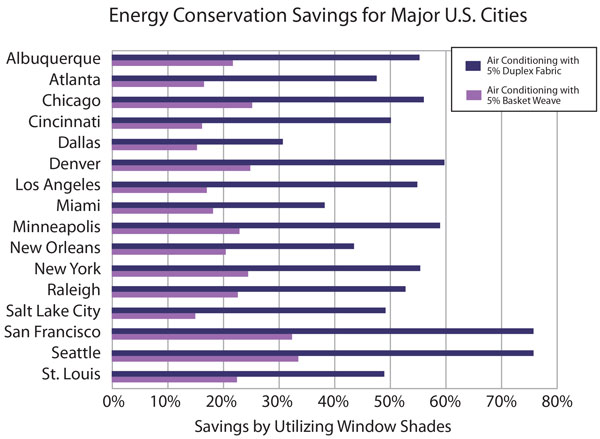Managing Daylight with Automated Solar Control
The location and positioning of certain shades may put them out of easy reach, making manual adjustments difficult or even unfeasible. Another consideration is the sheer number of shades on a floor, against a certain façade or within an entire building—it is improbable that they will be properly deployed consistent with effective solar strategies. Lastly, manual shades can adversely affect building appearance as they are often left in a variety of different positions, creating a haphazard, less-than-uniform look on the building exterior.
Automated shades, on the other hand, do not share many of the drawbacks of their manual counterparts. Daylighting with automated shades benefits building occupants in a number of ways, principally by increasing personal comfort. The shades are preprogrammed to help diffuse bright sunlight by lowering to a predetermined position based on various factors involving the arc of the sun as it moves in the sky. In addition to blocking direct sunlight, the adjustments maximize usable daylight. Via sensors near windows, shade positions can be altered to keep them lowered on bright days, and raised on cloudier days to admit the more diffuse light into the building interior. Aesthetically, automated shades are aligned to specific preprogrammed levels, making a clean, crisp statement from both the interior and exterior of a building. In order to achieve LEED IEQ Daylight, glare control devices such as automated or manual shades must be provided.
Traditionally, one stumbling block to the decision to go with automated shades has been cost. However, as the benefits of daylighting and solar heat gain control become more valued, and even required, the cost obstacle recedes. When considering the total cost of a project and the premium automated solar control carries over manual solar control, it is also important to keep in mind the conclusions of industry studies—frequently manual shades are only being moved once or twice a day, therefore rendering an otherwise solid daylighting strategy ineffective.
Automation has been part of the built environment for quite some time. No one would think to manually turn on and off the heating or air conditioning because of solar heating gain or heat loss; thermostats are left to tell the heating or air conditioning system when to turn on and for how long. Keyless access systems keep track of who enters what door and at what time, and even faucets, toilets, paper towel dispensers, and hand dryers are automated, all with significant savings in costs. The trend to automation is well established, and it is only a matter of time until automated shades become standard practice in buildings of all types.
Energy Efficiency
It is no surprise that buildings with window shades are more energy efficient than those without shades. The accompanying chart compares energy conservation with and without shades for identical buildings located in each of the major U.S. cities listed for one full year. As can be seen, utilizing appropriate solar shading can save from approximately 15 percent to 75 percent on cooling costs depending on the location and climate, and on what fabric is chosen. This simulation was performed with several constants:
Fabric: 5 percent basket weave fabric is a charcoal color; 5 percent duplex fabric is charcoal/white color (with the white side facing the exterior).
Solar shading: The horizon is presumed to be at a vertical level of 5°. No other obstacles or buildings are taken into account.
Glazed surface in facade(s): 50 percent of the facade total surface. U-value of glazing: 2.9 W/m²K (i.e. 0.15˝ or 4 mm glass).
This information refers to interior shades only.

Image courtesy of Draper, Inc.
Shades made with PVC-free fabrics result in further energy savings, control natural light to the best advantage, and contain recycled materials. They are thinner and lighter than PVC fabrics, so they require smaller tubes and hardware systems, leading to less waste, lower operating weights, and smaller “bundle diameters."









